2015 Lexus RC 350 and RC F First Drive

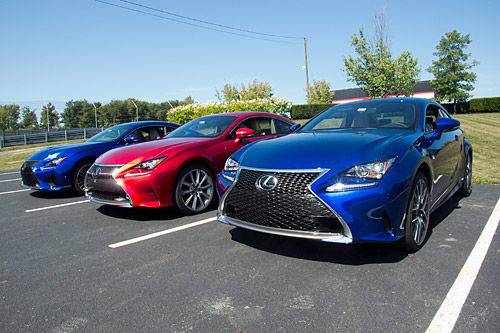
Specification sheets don’t tell the whole story, and if there’s a single brand that has illustrated this time and again, it’s Lexus. Parent brand Toyota plainly got out of the sporty car business a decade ago, but some Lexuses have continued to look the part. Even more important, the elements you look for — like generous power, rear-wheel drive and double-wishbone suspensions — have often been present. Regardless, they haven’t always translated to the emotional experience you expect, or at least desire, based on what you see in the specs. The new 2015 RC coupe, especially in RC F form, changes all of that in ways its predecessor, the IS-F sedan, failed to do.
Related: 2015 Lexus RC F at the 2014 Detroit Auto Show
The RC, a two-door four-seater, is intended to compete with the likes of Audi’s A5 and BMW’s 4 Series (that’s the former 3 Series coupe). It comes in three versions: the RC 350, the RC 350 F Sport (the regular car with substantial performance tweaks) and the RC F (a full-blown competitor for the Audi RS5 and BMW M4). I tested all three versions in New York state and at the Monticello Motor Club, a private racetrack in Monticello, N.Y.
Engines include the venerable 3.5-liter V-6 producing 306 horsepower in the RC 350, and an updated version of the 5.0-liter V-8 from the IS-F, producing 467 hp in the new RC F. Both engines drive the rear wheels through an eight-speed automatic transmission, though the RC 350 also offers all-wheel drive that instead pairs with a six-speed automatic.
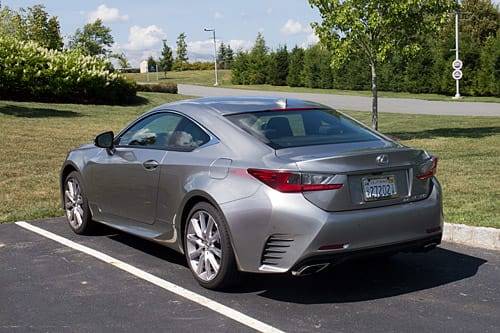
From the first mile or two I recognized the car is exceptionally rigid. Though Lexus says the RC’s platform is exclusive to this new model, the company kindly discloses that it borrows architecture from the larger GS sedan, the compact IS sedan and also the IS C, the convertible version that characteristically has additional reinforcement.
The rigidity comes across in both a solid feel and the handling, which is excellent. On the street, the midlevel car, the RC 350 F Sport, has a sporty feel even in normal driving — something many Lexus cars have lacked. The V-6 provides stout acceleration, and the eight-speed makes the torque peak of 277 pounds-feet more effective than I expected at its relatively high 4,800 rpm. The car hits 60 mph in less than 6 seconds with rear-wheel drive and sounds mighty good in the process.
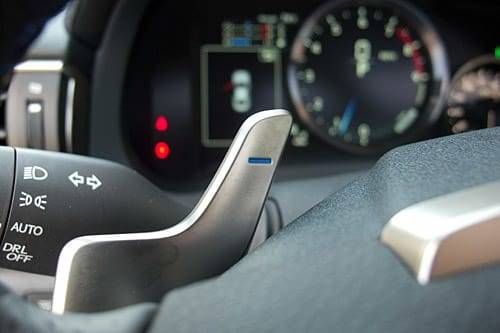
The F Sport treatment is essentially an option package that — among many other feature upgrades — adds an adaptive suspension system, the softest setting of which is considerably firmer than that of the base RC 350. (See the option details in our separate post on RC pricing.) Though the rear- and all-wheel-drive versions both offer F Sport, I drove an all-wheel-drive 350 without the package, and it definitely rode the most comfortably of the three cars, even though it was equipped with the optional 19-inch wheels. It did exhibit more body roll than the others, and having two fewer gears and more than 140 additional pounds, the all-wheel-drive version is the least quick as well. All the same, it felt reasonably sporty, due in part to the driveline’s 30/70 front/rear torque bias, which retains the feel of rear-wheel drive.
In addition to suspension changes, the F Sport version is eligible for an optional steering upgrade in the form of Variable Gear Ratio Steering plus four-wheel steering. Available only with rear-wheel drive, this system adds both a few degrees of rear-wheel steering and true variability to the front wheels’ steering ratio — meaning turning the steering wheel the same amount can actually result in greater or lesser steering angle depending on conditions and the driving mode.
For a car with all this steering trickery, it actually got around the track nicely. The ratio seemed right at different speeds, and the rear-wheel steering seemed to let the car turn a sharper corner. I’d need more time in the car to be sure, but the steering feel with the VGRS wasn’t bad. BMW had a similar system years ago, and it proved terribly unpopular, mainly because it deadened steering feedback (at a time when the regular steering had better feedback than BMWs have now).
Among the RC’s strongest suits are the brakes. From the RC 350 to the RC F, they all provide excellent linearity on both application and release and have good pedal feel. It’s a relief, frankly, because many Toyota-branded models disappoint in this regard. The front brake rotor diameters increase from 13.15 inches to 14.06 inches in the F Sport to 14.96 inches in the RC F. The RC F also upgrades to six-piston front and four-piston rear calipers from four- and one-piston front and rear calipers, respectively, in the lower versions.
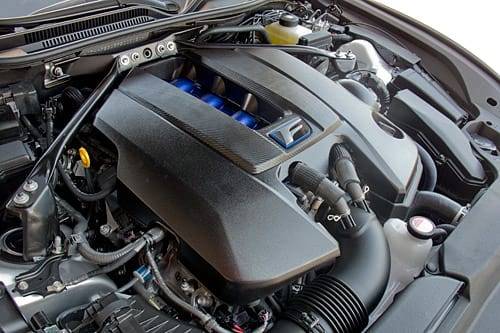
Though the V-6 impresses, the chassis clearly felt like it could handle more speed, especially on a track, and that’s where the RC F comes in. The RC F does away with the steering trickery and, unfortunately, also the adaptive suspension. The suspension proves brilliantly executed — the car’s reflexes sharp and the roadholding excellent — but a little adjustability would make for better daily drivability. (As important, the M4 does offer adaptive suspension.)
At a time when BMW has gone to a turbocharged six-cylinder in the M4, Lexus has recommitted to the V-8, which provides satisfying power and zero-to-60 mph times of about 4.4 seconds. Unfortunately you can’t go by displacement and cylinder count anymore, and the M4 provides more torque at lower rpm than the RC F’s 389 pounds-feet at 4,800 rpm. It’s also 373 pounds lighter than the Lexus and can hit 60 mph in just under 4 seconds with the automatic.
On the upside, the RC F’s V-8 provides more torque than the previous-generation M3’s did, and it still manages to beat that car’s mileage and match the new M4 in combined driving: The RC F gets an EPA-estimated 16/25/19 mpg city/highway/combined while the M4 gets 17/24/19 mpg.
The RC’s eight-speed has some pros and cons. Lexus cites shift times that are admirably fast for a conventional torque-converter automatic rather than a dual-clutch automatic like Audi and BMW use. It does shift quickly from one gear to the next — when it shifts — but occasionally it hesitates too long before doing so when you jab the pedal in an automatic mode. (I noticed the all-wheel-drive car’s six-speed kicked down to lower gears faster than the eight-speed does.)
The eight-speed is at its best during manual shifting and, surprisingly, on the track, especially in the RC F in its Sport S+ mode, in which it does an excellent job of picking the right gear going into and out of corners and continuously downshifts through the gears as you decelerate. I’ve come to view this capability as a necessity with an eight-speed automatic because — as I said in 2008 of the IS-F that hosted the first such automatic transmission in the market — having eight gears proves tedious when shifting manually.

All the cars have normal, efficient and sport modes, and the F Sport and RC F add a second sport mode. Unfortunately, the modes are among the RC’s flaws. Modes are fine in general, but many drivers inevitably prefer, say, their suspension one way and their steering another, and the pre-configured modes might not support that. Contrast the M4 and RS5, which provide independent control over the various systems and/or a customizable mode the driver can configure to suit. The 2015 M4 even has two of these customizable programs, activated by buttons right on the steering wheel.
Lexus does it right with the Torque Vectoring Differential that’s an option on the RC F. A single TVD button controls it alone, providing Standard, Slalom and Track modes that vary how the electronically controlled clutches distribute torque left and right. The system does a great job of tightening cornering, but I found the Slalom mode unsettled the car through Monticello’s demanding corkscrew section. Track mode was much better. For what it’s worth, the Torsen mechanical limited-slip differential (standard on the RC F) does an impressive job controlling the rear end in conjunction with the enhanced stability system, which Lexus calls Vehicle Dynamic Integrated Management.
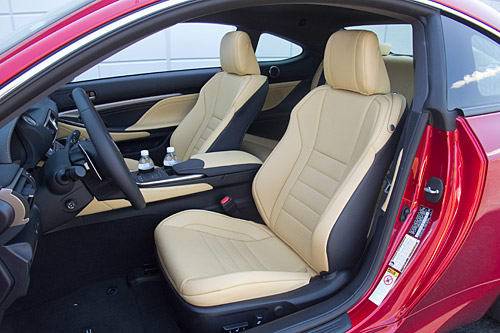
Really, integration is the story of the Lexus RC: Each of these cars feels like a complete system in which all the elements are meticulously well-matched. This is where I believe Lexus has failed in the past, even in the IS-F, which had an unruly rear end and countermeasures too clumsy to control it. The RC makes you feel like a better driver, an attribute in which the BMW M3 (now M4) has historically beaten all comers. We’ll have more on these cars, including their interiors and multimedia, in an upcoming full Cars.com review.
Cars.com photos by Joe Wiesenfelder

Former Executive Editor Joe Wiesenfelder, a Cars.com launch veteran, led the car evaluation effort. He owns a 1984 Mercedes 300D and a 2002 Mazda Miata SE.
Featured stories




